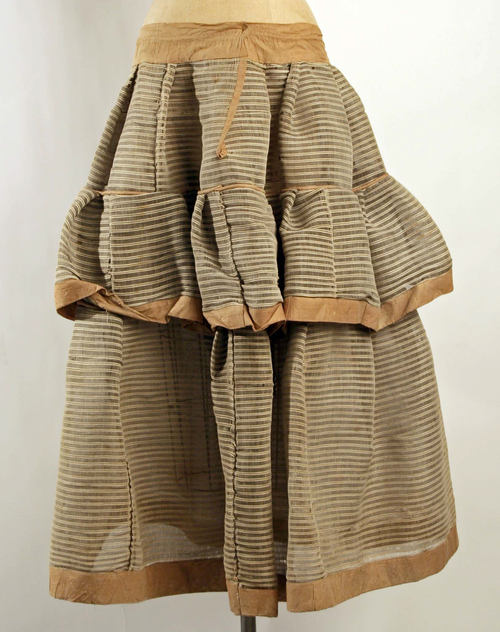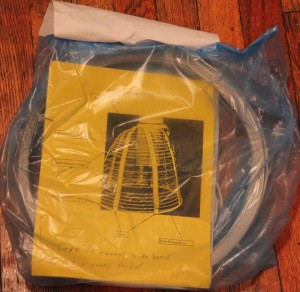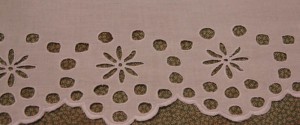Laundry Day
September 2nd, 2011
After three hot summer days of modeling in 19th century clothes, sweating profusely and getting drenched in a sudden thunderstorm, it was high time to wash my chemise and drawers.
If I was washing these in the 1850s, they’d be soaked in harsh soap, boiled, scrubbed and wrung out. Even so, I couldn’t bear to subject my embroidery to more than a gentle swish in a lukewarm bathtub. Then I wrung them out carefully — just squeezing the lace — and hung them to drip dry.
I was also reminded of this old English nursery rhyme, with its startlingly blunt conclusion:
They that wash on Monday
Have all the week to dry.They that wash on Tuesday
Are not so much awry.They that wash on Wednesday
Are not so much to blame.They that wash on Thursday
Wash for very shame.They that wash on Friday
Wash in dire need.They that wash on Saturday
Are lazy sluts indeed!
Crinoline!
September 1st, 2011
While I was stitching away on my petticoat seams tonight (they’re all done, and the hem — which is masquerading as the first tuck — is pinned in), I found this picture in the Met Museum’s collection database.
It’s dated 1840s, and boy is it a beauty! As I prepare to put my new cage crinoline together, I’m also eager to make a recreation cloth crinoline. Sadly, real crinoline — from the French word crin, a reference to the horsehair that provides its characteristic stiffness — is no longer available. But I am always on the hunt for a reasonable substitute.
Now at least I know what the finished product should look like.
Petticoat II
August 20th, 2011
I haven’t assembled my cage crinoline kit yet, so the skirt of my monumental broderie anglaise petticoat continues to languish in the closet. I need the cage — not to mention my new corset — in order to properly fit and balance the petticoat on its waistband.
Meanwhile, I’ve begun a crocheted edging for another petticoat. I’m using a pattern from Peterson’s, 1855 (I made a sample of this pattern earlier in the year):

I usually try to avoid crochet patterns that begin “work a chain slightly longer than desired.” I vastly prefer to work one entire repeat at a time, like knitted lace. Unfortunately, most crochet patterns require the header at least to be worked full-length, and this one is no different. After the header and top row of loops though, it’s worked by the repeats. So it could be worse.
It took me about 6 days of fitful work to complete the full-length rows. Now I’m happily hooking away on the fun part. I like to put three breadths of 45 inch cotton into my petticoats — a little narrow for the cage era perhaps, but I need them to be manageable over a horsehair crinoline as well. So, with about 135 inches in my hem, I decided to make 145 inches of edging. I’d rather have to ease the edging onto the hem than the other way round!
I want to get some nice cotton broadcloth (or a nice old sheet) for this petticoat. I’ll definitely tuck it, and have been considering some embroidered inserting, but that may be a bit much…
The real question is, what on earth am I going to do with all these fancy petticoats?
It’s Here!
August 2nd, 2011
The mail on Monday brought a grand surprise — well, not exactly a surprise since I placed the order myself last Thursday. But that didn’t diminish the thrill with which I tore open the box!
Yes, it’s the Wooded Hamlet cage crinoline kit. I am terrified to assemble it, but also eager to get my hands on those deliciously slender watch-spring steels. They’ve really done an admirable job reproducing the materials — from the steel to the pocketed tapes to the tiny metal findings that hold it all together. I have an original early 1860s cage that I purchased on Ebay for a song a few years back (they had it listed as something else entirely) so have been able to make up close comparisons. That reminds me…I should bring my original cage home from where it’s stashed and take some detailed photos to share with you.
Until then, you’ll find me with the 9 inch pliers, assembling my new cage crinoline. Advice from anyone who has already done this very much appreciated! And to my dear friend who may get one too — do it! And we’ll assemble them together.
Last but not least, a hearty vote of thanks to mater and pater, who provided the funds for this extravagance on the occasion of my last birthday.
Fait Acompli
July 30th, 2011
I can hardly believe it, but I have finally finished my broderie anglaise petticoat frill. It’s taken the better part of a year, but it’s really done. Scallops and all. When you add in the months I spent tucking and embroidering the petticoat to which this frill will soon be attached, I’ve spent almost exactly a year and a half on a single petticoat. To be fair, I worked in fits and starts, sometimes ignoring it entirely for 6 weeks. If I was to work steadily, and with the proper materials, I’m sure I would have taken only a fraction of the time.
There’s a great deal wrong with it, but it’s all little technical stuff. Overall, the effect is really rather wonderful (at least to my easily pleased eye) and I can’t wait to see it all put together!
What’s wrong, you ask? Perhaps to avoid pitfalls with your own frills, or maybe you just like to gloat? Well, I’ll tell you. First of all, I wasn’t nearly regular enough in transferring my design. I should have pounced it, or at least taken a bit more care when drawing it on. I also made the circles too small. Then, I used a single thread of standard embroidery floss — made even thinner because it was an off-brand. I should have used real coton a broder, probably in two different sizes for padding and stitching, or at the very least, two strands of the embroidery floss. I might then have made the border round each circle properly thick and glossy.
I’m fairly happy with the scalloped edge though — I used a double strand of floss and it turned out quite nicely. Of course I should have done the bottom row of circles differently, so that they would be more united with the scallops instead of seeming to clash with them. Ah well. There’s always next time.
For now, I have only to put a tiny hem into the top of the frill and sew it under the bottom-most tuck of my petticoat. I haven’t attached the petticoat skirt to a waistband yet. I plan to cartridge pleat it of course, and find some pretty little milk glass buttons for the band. I know tapes would be better, but somehow I just can’t bear the idea of sloppy tapes (tapes are invariably sloppy, no matter how neatly they are arranged) marring my beautiful petticoat.
But before I can fit the skirt for length and balance it, I need my new cage! Yes, at long last I have ordered a cage crinoline kit from Wooded Hamlet. It’s amazing how close they’ve come to matching materials used in actual cage crinolines of the 1850s. But that’s another post entirely…
Also coming up soon — a preview of my someday-to-be-given tell-all lecture on broderie anglaise and its social implications in mid-19th century England & America.
« Newer Posts — Older Posts »




